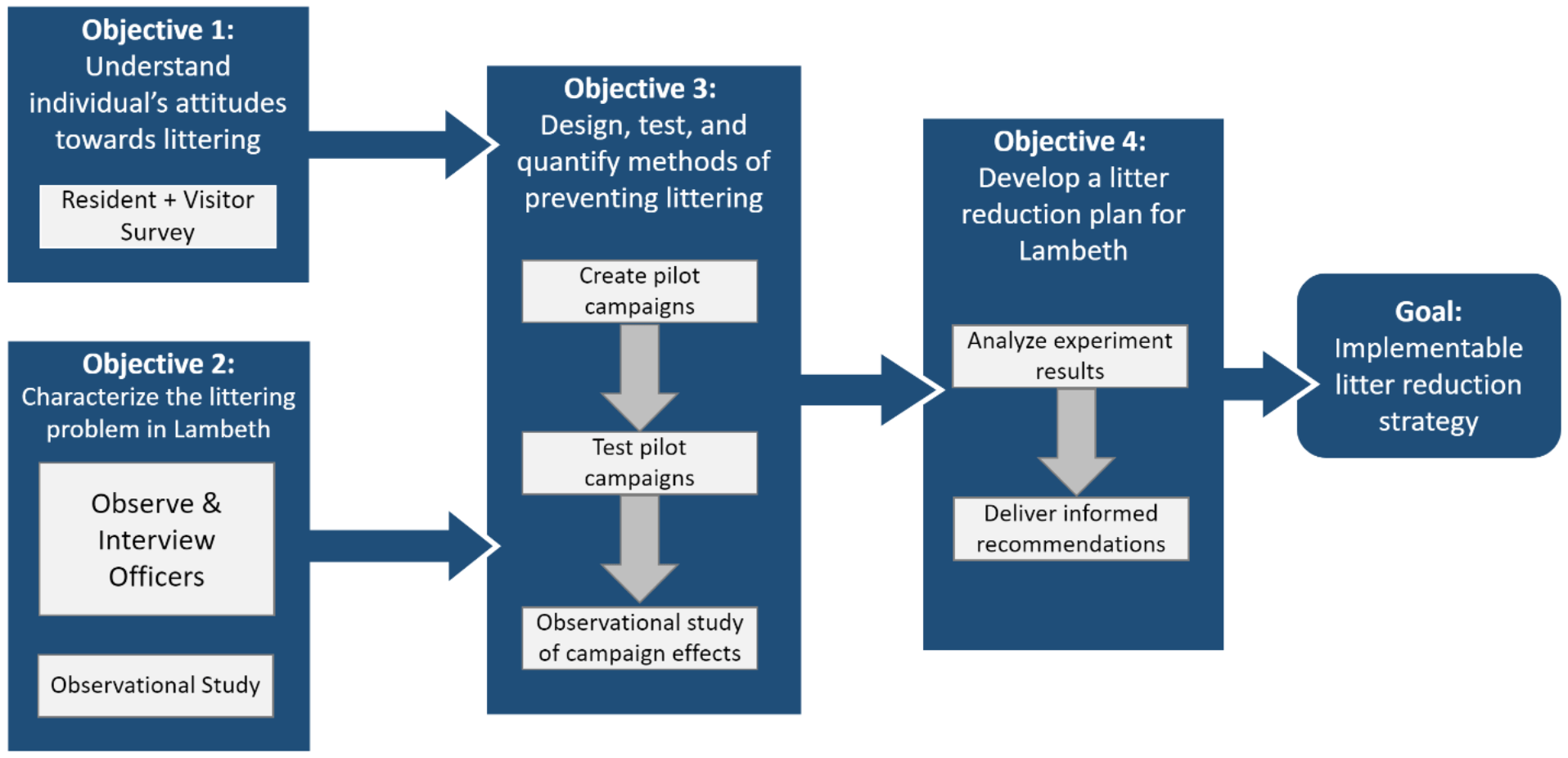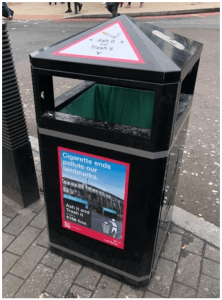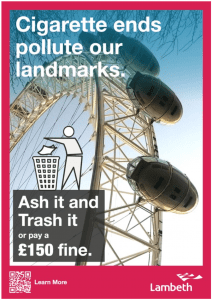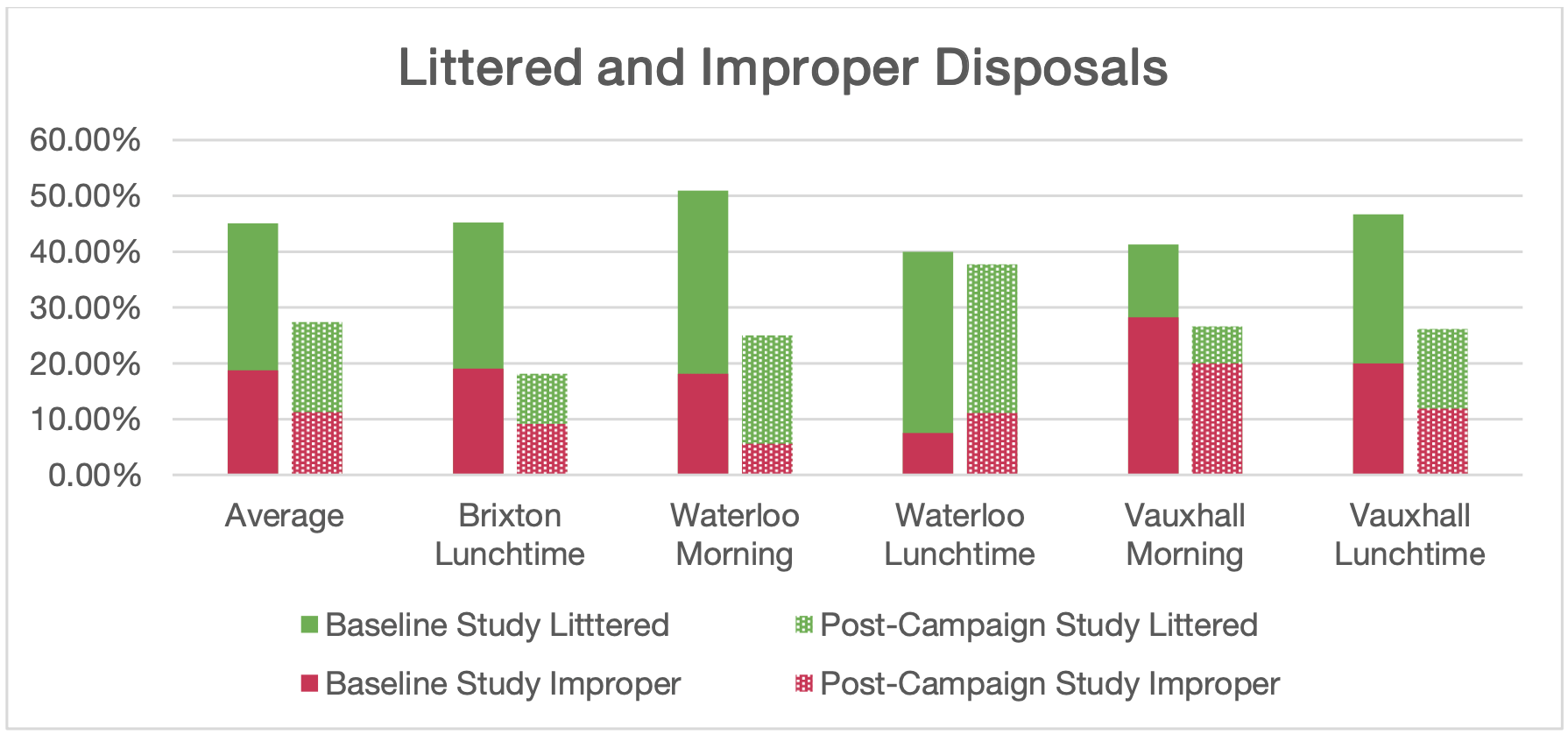Littering in Lambeth
Executive Summary
The accumulation of litter in cities is not only aesthetically unappealing, but it represents a serious threat to societies and their inhabitants. Annually, over 4.5 trillion cigarette butts are littered worldwide; these butts contain toxic chemicals which represent a serious threat to our environments (“The Facts About Litter,” 2017). Ultimately, responsibility falls on local governments to delegate and fund cleanup efforts, which cost the United Kingdom upwards of £663 million in 2018.
Street litter accumulates in areas with high foot traffic and where people loiter. In Lambeth, this is around major transportation hubs, such as Waterloo, Vauxhall, and Brixton stations, and tourist attractions like the London Eye, Royal Festival Hall, and the London Aquarium (A. Brandon, A. Skilton, & G. Brown, phone interview, November 13, 2019; “Video Tour of Lambeth in London,” 2015). Currently, Lambeth Council issues Fixed Penalty Notices (FPNs) as their primary tool to reduce littering. These FPNs require that offenders pay £150, which can be reduced to £100 if paid within the first ten days, to bypass a court trial. The officers responsible for issuing FPNs are contracted by the Council and work for a company called APCOA (APCOA Parking, 2016).
Project Goal and Methodology
The goal of this project was to develop and test an implementable anti-littering strategy to assist Lambeth Council in addressing the problem of excessive littering in their borough. To accomplish this goal, the team spent the first seven weeks of our project at WPI developing objectives with corresponding tasks. These objectives were completed sequentially and built off of each other to reach our goal. A model of our objectives, with each specific task shown in a white box, is presented in the figure below:
As shown in the figure, the first two objectives primarily featured data collection and were conducted simultaneously. Information gathered from these objectives allowed us to design and test a littering reduction campaign. Based on the success of our campaign and our research into effective anti-littering strategies, we were able to develop a litter reduction plan and ultimately accomplish our goal.
Design and Implementation of the Anti-Littering Campaign
Results of The Campaign
After our post-campaign studies were completed, we calculated the percentage of cigarettes that would become litter (littered plus improper disposals) dropped to 27.5%, which was a 39% reduction from the 45% in our baseline study. This result was statistically significant (p < 0.5), with a p-value of .008.
In locations where our bin topper was present (Waterloo and Vauxhall), we recorded a 37% decrease in improper disposals from 18.7% to 11.8% (p = .08). This result is not sufficiently statistically significant; however, we noticed through the course of our study that many individuals noticed our stickers and appeared to read them and proceeded to cautiously stub out their cigarette and throw butts away like it was perhaps their first time. Due to this, we believe that placing educational messages on top of bins could reduce the amount of cigarette litter.
Recommendations for Lambeth Council
Based on our findings we came up with five recommendations for Lambeth Council to, over time, reduce the amount of street litter in their borough:
- Future anti-littering advertisement campaigns,
- Ashtray and litter bin design improvements,
- Locations of litter bins,
- Volunteer litter cleanup events, and
- Student education about littering.
Future Anti-Littering Advertisement Campaigns
This recommendation is based largely on the success of our own campaign and provides suggestions for Lambeth Council in their own advertisement campaign. When designing their posters, the Council should build off their resident’s community attachment and display the monetary penalty of FPNs. We recommend they begin educating smokers on improper disposals by issuing FPNs. Finally, their campaign should be implemented in high traffic areas like transportation hubs and around tourist attractions.
Ashtray and Litter Bin Design Improvements
During our time in Lambeth, we observed many flaws in current litter bin designs. We recommend that future litter bin designs include large, easy to use ashtrays, clearly visible stubber plates, and two compartments that allow for easy disposal of waste and recycling. Since this could be costly and a long-term change, in the meantime, we suggest that the Council clean the ash and grime off litter bins to nudge patrons to properly use bins.
Locations of Litter Bins
We were also tasked with identifying if the current placement of litter bins was effective. We noticed most bins were placed curbside, with lots of bins distributed around major transportation areas and bus stops. We observed one particularly poor placement outside of Vauxhall station, where bins were irregularly clustered together. We recommend that Lambeth Council redistribute these bins to cover a wider area. Another behavior that we observed was that smokers often smoked near station entrances where there were no accessible litter bins. We recommend that the Council consider placing ashtrays by the entrances to give smokers a convenient way to properly dispose of their cigarettes.
Volunteer Littering Cleanup Event
One effective campaign that consistently came up in our research was a community cleanup day. We found that 54% of residents showed interest in a cleanup event. By organizing a community cleanup, the Council would spread awareness about the litter problem and help to create a clean environment where people will be less likely to litter. To help accomplish this, we recommend the Council work with local businesses to help fund an annual event.
Student Education About Littering
Our final recommendation was to educate the younger population about the negative impacts of littering. This could be done in an individual classroom or schoolwide setting. After students learn about the negative effects, we recommend they apply their knowledge by either creating anti-littering posters or painting litter bins with classmates that could be used by the Council.







